#cucurbit leaf beetle
Photo
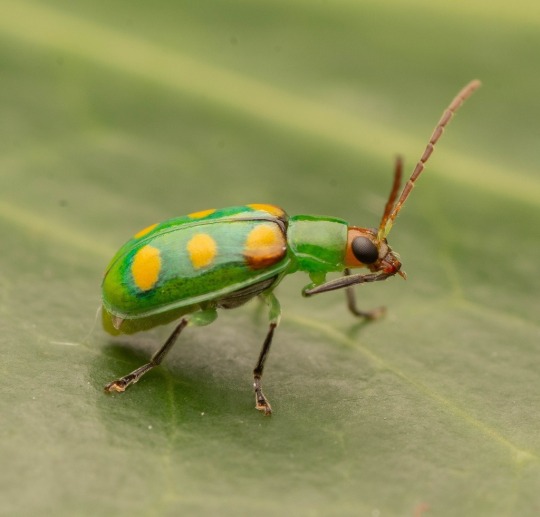

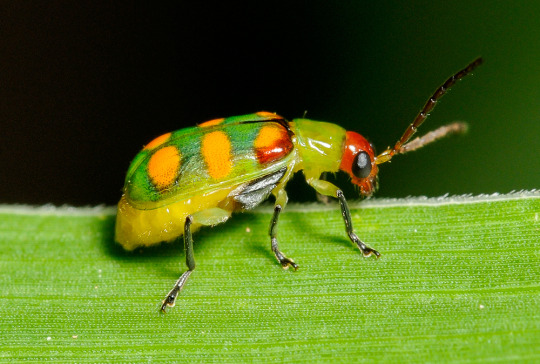

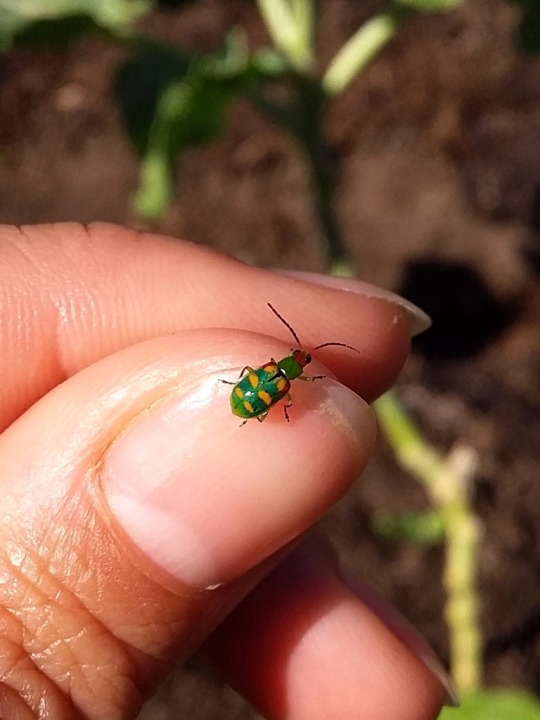
Cucurbit leaf beetle (o vaquita de San Antonio en Español), Diabrotica speciosa, Chrysomelidae
Found in South America
Photo 1 by acosta91, 2 by robertolemos, 3 by perksimages, 4 by biobrunno, and 5 (for scale) by joanapereira
#animals#curators on tumblr#insects#bugs#beetle#leaf beetle#cucurbit beetle#cucurbit leaf beetle#one nice bug#i just think they're cute :)
869 notes
·
View notes
Photo
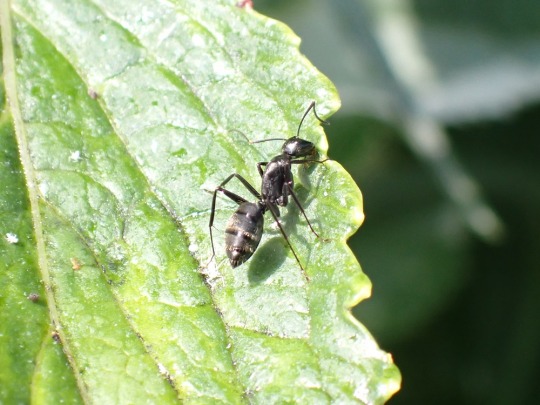


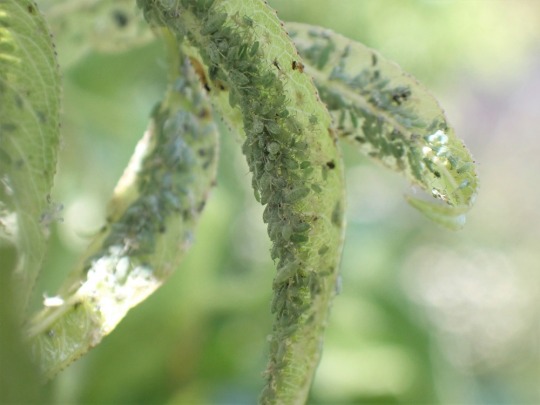

アジサイの葉にクロオオアリ(5月25日)こんなところで何を舐めているのか?
セイヨウミツバチがアジサイの蕾で何か舐めている。花蜜はありそうにないが。
アジサイの蕾にはウリハムシもいた。おいしそうに何を舐めているの?
よく見ると、アジサイの上にあるハナモモの木にアブラムシがびっしり付いていて、そこらじゅうべとべとしている。このアブラムシの分泌物がアジサイに落ちていて、それを舐めているようだった。
よほどおいしいらしく、セグロアシナガバチも夢中になってかぶりつきで舐めていた。
#Camponotus japonicus#Japanese carpenter ant#ant#mrówka#Apis mellifera#honey bee#pszczoła miodna#Aulacophora femoralis#cucurbit leaf beetle#Aphidoidea#aphids#greenfly#blackfly#mszyce#Polistes jokahamae#paper wasp#Polistes#osowate#japan#hydrangea#hortensja#peach#brzoskwinia
3 notes
·
View notes
Text
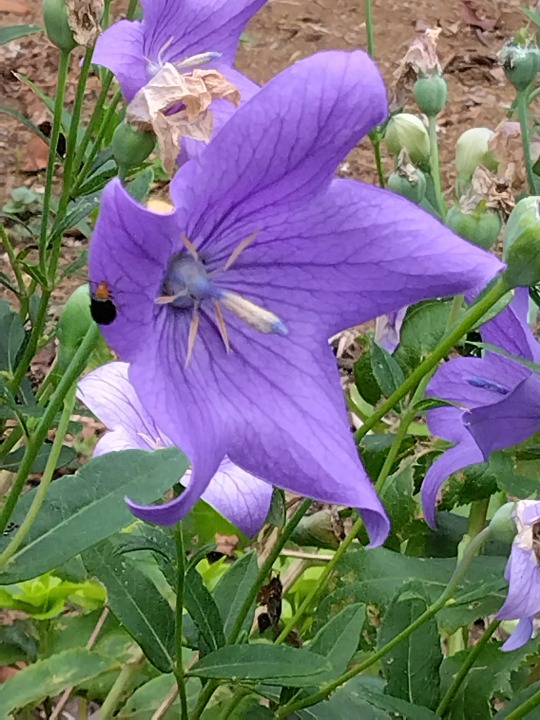
庭の花 (クロウリハムシ付き)
Flowers in the garden (with Cucurbit leaf beetle)
11 notes
·
View notes
Text
Leaf Mosaic
Leaf mosaic is a non-lethal disease that is caused by various plant-pathogenic viruses. It occurs on a wide range of crops and plants.
It is spread by weeds, infected seeds or seedlings, and insect vectors such as aphids, whiteflies, and cucumber beetles. It can be prevented by using virus-free varieties, separating new and old plantings, weeding and pest control.
Symptoms
Leaf mosaic virus infections cause a plant to develop a mottled or spotted appearance on its leaves. It can also lead to stunted growth, reduced yields, and death in severe cases.
Mosaic viruses affect a number of horticultural crops, including tomatoes, peppers, cucumbers, alfalfa and tobacco. They are transmitted by weeds, infected seeds and infected plants.
Cucurbits: CMV symptoms vary with the cultivar and species, but typically are characterized by severe epinasty, downward curling of young petioles and a mosaic pattern. Leaves and stem internodes are severely reduced, and the fruits appear small.
Flower/fruit: Flowers are misshapen, develop greenish petals and abnormal coloration. Fruits are distorted and discolored, often remain small and are not a good source of seeds.
Tobacco mosaic virus has an extensive host range and affects a variety of greenhouse crops, such as petunias, calibrachoa, lobelia, impatiens, chrysanthemums and tomatoes. It can be difficult to distinguish between symptoms caused by several viruses, so it is best to know the symptoms of each type before attempting to diagnose the plant.
Detection
Typical leaf mosaic symptoms include broken yellow streaks running between veins on an otherwise green blade (Figure 1). Mosaic patterns vary among grass varieties and species that show the symptom and can change in appearance as the disease gets worse.
Leaves that are infected at a young age often fail to grow to full size. They may exhibit a mosaic or mottling pattern and, in some lettuce varieties, have distorted leaves that can’t expand.
The most common way that mosaic virus spreads in a field is by seed. Gardeners can reduce the threat of this disease by using trap crops and planting resistant types near vulnerable ones to keep aphids away.
Tobacco mosaic virus is one of the most widely studied and important plant viruses. It infects a variety of horticultural and vegetable crops, including tomatoes, peppers, and lettuce.
Prevention
Mosaic virus is one of many plant viruses that cause a variety of symptoms in plants. Symptoms vary depending on the strain of virus and the environment.
Viruses affect a range of crops and are often spread by insects, fungi, seeds or contact with infected weeds or other infected plants. Infected leaves often show irregular leaf mottling, ring spots or streaks of light and dark green tissue (mosaic).
If you’ve noticed leaves in your garden showing a mosaic pattern, it’s important to take steps to prevent the disease from occurring again. This can include using only virus-free seed, separating new from old plantings and rotating annuals.
It is also important to practice good sanitation and pest control practices. For example, if you suspect lettuce mosaic on your salad greens, remove all infected leaves and destroy them before disposing of them. This will help prevent the virus from spreading to other lettuce or spinach varieties. Using tested, clean lettuce seed is also important in preventing this disease from taking hold.
Treatment
Whether you’re buying a plant, starting your garden, or harvesting the crops, it’s important to know what diseases can harm them. With thousands of different viruses out there, having a knowledge of what can kill your healthy plants is essential.
One of the most common types of garden viruses is mosaic virus, which can cause leaf and fruit discoloration and distortion. Mosaic viruses can be spread by aphids and other insects, as well as through contaminated soil, seeds, and growing media.
In addition to insect control, other ways of preventing mosaic virus include crop rotation, weeding, and uprooting diseased plants. You may also want to plant resistant varieties, if available.
Symptoms of leaf mosaic vary, but are typically visible on leaves and young fruits. They include mottled, yellowed, or twisted leaves, as well as distorted new shoots. These symptoms can be especially apparent on sunny days.
0 notes
Photo

Cucurbit leaf beetle.
10 notes
·
View notes
Text
I love greenhouse growing. I do. In the winter, it's one of the only ways to grow things here in New England. But it comes with its own host of problems, and my hands-down least favorite is the green peach aphid.
The green peach aphid is a pest that typically targets peach trees, and other fruits in the same family, however they're opportunistic feeders and will also target beans, eggplant, tomatoes, peppers, sweet corn, and cucurbits like cukes and squash.
They're also universal vectors for disease, which means that they can infect just about everything they feed on.


On the left we have some spinach that my coworker cut maybe 20 minutes ago. I just washed it and it looked great. On the right is a leaf of spinach cut from a second bin, from a different area of the greenhouse. Those guys are aphids.
They're voracious feeders that can wipe out an entire crop in just a matter of weeks, so scouting for them and taking action before their numbers build too high is key. The economic threshold (the amount of insects seen on a plant that affect marketability) for spinach is only 4 aphids per plant. When you see that photo up there, the situation seems pretty dire.
But all hope isn't lost. There's lots of ways to control them. Praying mantises eat them, as do ladybugs and some other varieties of beetle, as well as spiders and wasps. So there's lots of stuff that eat them during the season when the weather is nice.
But in the winter, in the greenhouse, we have to use chemical controls. Insecticidal soap is organic (meaning OMRI registered) and washes off easily when we wash spinach. It also has a very short re-entry interval (which is the amount of time that must pass after application before being able to go back into the treated area.) The downside is that the soap must hit the bosldy of the aphid to be effective. Since they live on the underside of the leaves, this can be tricky.
Other insecticides are more effective, but they're also more damaging to other organisms and have longer re-entry intervals. Systemic pesticides, can even amplify the effects of diseases in crops, so you have to decide what you're treating for before you decide to make a move.
Have a farming question? Ask me!
53 notes
·
View notes
Text
19 through 23 November 2018
This was a three-day work week for me and two Thanksgiving dinners! Monday I returned from Italy. Tuesday Wednesday morning we were treated to a herbarium workshop. Last April we collected and pressed some plant material from the garden. I chose Polemonium reptans L. accession 2015-0288/3 located in the North American woodland. Jill ensured they all dried properly. We had the opportunity to mount our specimen. It was a great morning.

Wednesday afternoon I spent with Susyn working on taxonomic questions. Thursday morning Franzsika and I went to collect some variegated ivy that was used for the Christmas Fayre over the weekend. That afternoon I had time to work on the records. In the evening, I was treated to a Thanksgiving dinner, on the actual day, with friends. My first Thanksgiving that was’t my own in two decades. It was a very nice treat.
Friday I ran errands, including meeting Jody and Steve in the morning. I spent the afternoon with Elizabeth preparing for our Thanksgiving the following evening. Then I met with Jody and Steve and we watched Aladdin in the West End. Thanksgiving was a blast and we didn’t get home until 3am. We spent Sunday recovering.
Medicinal plant of the week is Ziziphus jujuba. Allison brought some fruit to the meeting and it was small and delicious.
New plant ident:
Amaranthaceae Amaranthus hybridus
Amaryllidaceae Nerine bowdenii ‘Vesta K’
Apiaceae Eryngium bourgatii ‘Picos Blue’
Asteraceae Argyranthemum pinnatifidum subsp. pinnatifidum
Asteraceae Chrysanthemum nankingense
Begoniaceae Begonia soli-mutata
Crassulaceae Kalanchoe delagoensis
Ginkgoaceae Ginkgo biloba
Salicaceae Salix alba
Thymelaeaceae Daphne bholua ‘Jacqueline Postill’
Plant of the week
Cucurbitaceae Luffa aegyptiaca Mill. or Luffa cylindrica (L.) M.Roem.
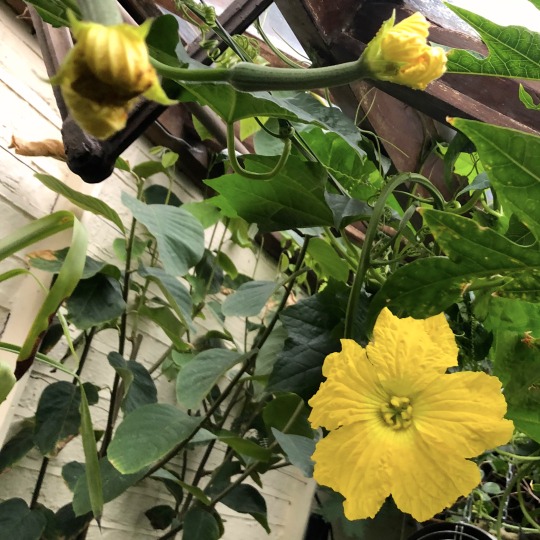
common name(s) - sponge gourd, Egyptian cucumber, Vietnamese luffa, dishrag gourd, rag gourd, sponge gourd, vegetable-sponge, smooth luffa; Arabic اللوف; French courge torchon; Portuguese bucha
synonym(s) - Bryonia cheirophylla Wall.; Cucumis pentandrus Roxb. ex Wight & Arn. [Invalid]; Luffa acutangula var. subangulata (Miq.) Cogn.; L. aegyptiaca var. leiocarpa (Naudin) Heiser & E.E. Schill.; L. aegyptiaca var. peramara F.M.Bailey; L. cylindrica var. insularum (A.Gray) Cogn.; L. cylindrica var. leiocarpa Naudin; L. cylindrica var. minima Naudin; L. insularum A.Gray; L. leucosperma M.Roem.; L. pentandra Roxb.; L. petola Ser.; L. subangulata Miq.; L. sylvestris Miq.; Melothria touchanensis H. Lév.; Momordica carinata Vell.; M. cylindrica L.; M. luffa L.; M. reticulata Salisb.; Poppya fabiana K.Koch; Turia cordata Forssk. ex J.F Gmel.; T. cylindrica Forssk. ex J.F Gmel.; T. sativa Forssk. [Invalid]
conservation rating - none
native to - Southeast Asia
location - tropical corridor, accession 2018-0254
leaves - five angled stems with tendrils on the axils of leaves to facilitate climbing, leaves are broadly ovate to reniform, dark green with silvery patches on the topside, five to seven deep lobes, dentate, scabrous, apex acute, base cordate, petiole hispid and 50mm to 100mm long
flowers - monoecious, produced on leaf axils, and consist of five petals of a conspicuous yellow colour, 50mm to 100mm across, united below in a bell-shaped corolla; fruit, grouped as pepo, approximately 300mm long, resembles a cucumber in shape and size; fruits take three to four months to ripen
habit - annual climber
habitat - tropical and subtropical climates, requires warm summer temperatures and a long, frost-free growing season
pests - cucumber beetles, aphids (e.g. Aphis gossypii)
disease - downy mildew, powdery mildew, alternaria blight, angular leaf spot
hardiness - >15ºC (H1a)
soil - moisture of at least 10% to 15% above the permanent wilting point is required to maintain growth; well-drained sandy loams are preferred; is sensitive to acid soils; the optimal soil pH is 6.0 to 6.8
sun - full sun, average temperature should be around 30°C to 35°C
propagation - seed
cultivation - best grown with a trellis support; requires lots of heat and lots of water to thrive
nomenclature - Cucurbitaceae - cucurbita - the Latin name for the bottle-gourd, Lagenaria siceraria; Luffa - loofah, from the Arabic name, louff, for Luffa cylindrica; cylindrica - long and round, cylindrical
NB - The young fruit is eaten as a vegetable and is commonly grown for that purpose in tropical Asia. Unlike the young fruit, the fully ripened fruit is strongly fibrous and inedible, and is used to make scrubbing bath sponges. An edible oil can be extracted from the seeds. The resulting oil meal can be fed to rabbits and catfish, or used as a fertilizer.
References:
CABI [online] https://www.cabi.org/isc/datasheet/31693 [27 Nov 18]
Gledhill, David, (2008) The Names of Plants, fourth edition; Cambridge University Press; ISBN: 978-0-52168-553-5
IUCN [online] http://www.iucnredlist.org/search [27 Nov 18]
Ontario Ministry of Agriculture, Food and Rural Affairs [online] http://www.omafra.gov.on.ca/CropOp/en/spec_veg/cucurbits/luffa.html [27 Nov 18]
Plant List, The [online] http://www.theplantlist.org/tpl1.1/record/kew-2338909 [27 Nov 18]
Wikipedia [online] https://en.wikipedia.org/wiki/Luffa_aegyptiaca [27 Nov 18]
2 notes
·
View notes
Text
6 Bizarre Things That Happen When It’s About to Storm
Culture
Marissa LaliberteJul 06
Even when you can’t find a weather report, nature gives its own signs that a downpour is on its way.
Tree leaves turn over
Tlapy007/Shutterstock
This old wives tale is actually valid. Before a storm hits, the humidity usually skyrockets, which makes the leaf stems on trees that drop their leaves in autumn go limp. Without their usual rigidity, those leaves show their undersides when the wind rustles them.
Bugs get less frisky
Sergey/Shutterstock
When barometric pressure drops before the rain, bugs lose interest in mating, according to a study in PLoS ONE. Researchers looked at the mating behavior of different bug species—cucurbit beetles, potato aphids, and true armyworm moths—and all three species had similar reactions. When it felt like it was going to rain, the females put out fewer mating signals, and the males didn’t react as strongly to their pheromones. The bugs would still have sex if they were put near each other, but they’d get it over with quickly instead of going through their full mating rituals.
Birds might flee
artjazz/Shutterstock
In 2013, scientists tracking golden-winged warbler migrations were confused when the birds suddenly fled the Tennessee mountains, each traveling solo rather than in a flock. There was a storm brewing 560 miles away, but there was seemingly nothing that could have clued them in—the wind speeds, precipitation, and atmospheric pressure hadn’t changed. After the storm passed, the birds came back. Researchers figure the birds can sense sounds that are too low for humans to hear. Check out these other 22 things you didn’t know about thunderstorms.
The air’s scent changes
Peangdao/Shutterstock
It’s not just in your head—there really is a certain smell in the air before the rain hits. That fresh scent you detect is coming from the ozone. As a storm approaches, the downward draft of air pushes ozone molecules closer to the ground, where they reach your nose.
Original Source -> 6 Bizarre Things That Happen When It’s About to Storm
source https://www.seniorbrief.com/6-bizarre-things-that-happen-when-its-about-to-storm/
0 notes
Text
Why Rotating Vegetables in the Garden is Crucial
Could over a million lives have been saved between 1844 and 1846 by rotating vegetables in the garden?
Several factors contributed to the Great Famine. Irish families lived on small tracts of land owned by the ascendancy class. A third of small holdings could not support families after paying rent. Farmers lived at subsistence level. They grew two heavy-yielding types of potatoes, which thrived in poor soil, and half of Ireland’s population depended on this crop for survival.
Then, late blight struck. It came accidentally from North America, unrecorded in Europe prior to 1844. Fed by unusually damp conditions, it ravaged the fields. Crop loss in 1845 ranged from a third to a half of cultivated acreage. In 1846, more than three-quarters of the harvest perished, including many seed potatoes that would have started a new crop. The first starvation deaths were recorded that year.
Modern farmers recognize the dangers of blight and know that rotating vegetables in the garden is crucial for protecting a harvest. If the Irish had a secondary crop, unrelated to potatoes, and rotated it through the fields, could deaths have been prevented?
An Ancient Concept
The earliest examples of crop rotation were used in the Middle East. They didn’t understand why alternating legumes with cereals resulted in better yields, but they knew it worked. Early Europeans used the two-field system, where one allotment sprouted thick with wheat, rye or oats, while the other lay unplanted. Medieval fiefs added a third field, once again incorporating beans and peas into the rotation, but allowing one field to lay unused didn’t make sense to feudal peasants. Livestock roamed the fallow field, consuming weeds and wheat stubble while fertilizing the ground with manure.
By the 17th century, Charles Townsend of Norfolk County, England, eliminated the fallow field and replaced it with cover crops such as clover and ryegrass, which provided livestock fodder while still replenishing the soil. These cover crops produced richer manure because animals were more nourished.
Take the Stress Out of Finding the Right Small Farm Tractor for You!
Download this FREE Guide right now.
YES! I want this Free Report »
Other advocates encouraged the practice, such as George Washington Carver, who taught southern farmers to rotate other plants with the cotton, which when raised alone, quickly depleted the soil. Adding peanuts and sweet potatoes gave farmers alternative cash crops while increasing yields when cotton was replanted. Discovery of cover crops for gardens eliminated the need for fallow fields in much of the world.
The Green Revolution took hold and a majority of the modern world turned to chemical fertilizers, relieving some of the need for crop rotation. But organic growers still attest to why rotating vegetables in the garden works.
The Science Behind it All
If you planted tomatoes in a raised bed last year and they performed delightfully, sprouting high and dark green while hanging heavy with fruit, should they perform as well this year? Planting tomatoes in the same location, year after year, is a bad idea.
Rotating vegetables in the garden reduces soil erosion, replenishes nutrients, and mitigates pathogens and pests, which attack certain species of plants.
Cover crops like clover help reduce soil erosion and replenish nutrients.
Along with the Great Depression came agricultural tragedy. The Great Plains seemed perfect for growing cereal grains, but farmers didn’t understand the specific ecology. They dug deep with their plows, ripping out native grasses and churning up virgin topsoil. Cotton stripped away nutrients and farmers burned stubble, removing organic vegetation. Soil was left bare during the winter. During fruitful years, wheat and cotton sprouted to hold the soil in place. But drought struck in three waves. The unanchored soil turned to dust, blowing in immense clouds depicted in windswept sepia photographs.
A happier story depicts how rotating vegetables in the garden builds topsoil and prevents erosion. In 1988, a study compared two adjacent farms within Washington state. The organic farm had six inches more topsoil than the conventional operation next door. Both farms had been established 80 years earlier. The organic farm had remained organic, using crop rotation, while the conventional land began administering fertilizers and pesticides. The additional topsoil was attributed to usage of green manure crops rather than relying on chemicals.
Russet potatoes, ready for the kitchen. Photos by Shelley DeDauw
But what about nutrient replacement? High school chemistry explains that. By studying the periodic table, we learn that vitamins and proteins may be created or consumed, but elements cannot. Iron has always been, and will always be, iron. Conventional fertilizers contain nitrogen, phosphorus and potassium, the three most important nutrients to plant growth. But healthy food crops need more than NPK. Tomatoes get blossom end rot without enough calcium. Magnesium helps flowers develop and seeds germinate. Spinach is high in manganese, iron, copper, and zinc, and all elements must come from the soil. If a “heavy feeder,” such as cotton, grows year after year in the same spot, eventually those elements will no longer be available.
Science also explains why crop rotation benefits disease resistance. Late blight was a problem for Ireland. But it would not have been a problem if the tenants had grown sweet potatoes instead. Why? Because potatoes are a nightshade while sweet potatoes belong to the morning glory family. Blight-infested soil is not hazardous to the family Convolvulacaea.
Many other diseases are plant-specific. Sweet potato feathery mottle virus only affects sweet potatoes. Gummy stem blight attacks cucurbits, but not tomatoes or peppers.
Insects and other pests have their favorite foods. Squash bugs also attack cucumbers and melons, though they prefer squash itself. Other pests that love the Cucurbita family include cucumber beetles, spider mites, and melon aphids. They overwinter in garden soil or beneath mulch or rocks. In the spring they emerge to feed again. Though treatment methods range from smashing the bugs to pesticides, the best way to keep these bugs away from crops is to make sure their favorite food isn’t planted in the place they found shelter.
Keep It All in The Family
Do you practice the two-field system or use four fields? Incorporate green manure or legumes? And just when should clover be established?
It’s quite confusing.
But rotating vegetables in the garden doesn’t have to be so scientific. Just remember: keep families moving and don’t split them up.
More from the potato harvest. Rotating sweet potatoes, in the morning glory family, with Russets (pictured), from the nightshade family, will help reduce the odds of disease affecting your crop. Photo by Shelley DeDauw
A simple crop rotation plan for home gardeners involves the Three Families method. Each bed will have one of three families: Solanaceae (nightshades), Fabaceae (peas and beans), and a third family. This family can include Brassicaceae (mustards and broccoli), Apiaceae (carrots and parsley), Alliaceae (onions and garlic), or Cucurbitaceae (squash and melons). Or throw in the family of beets, Swiss chard, and spinach. Perhaps sweet potatoes. Maybe corn. Choose your third family based on what your family will eat, what grows well, and pests or diseases that may have been a problem in previous years.
The nightshade family includes tomatoes, tomatillos and ground cherries, both sweet and hot peppers, eggplant and potatoes. This is probably the most popular family for home gardeners who can’t live without their tomatoes or salsa. But nightshades can be susceptible to a spectrum of diseases such as blight, Fusarium and Verticilium wilt, and leaf curl virus. Some strains are more resistant than others but it’s safest to move all nightshades to a new spot each year. Never use soil from last year’s nightshade location for this year’s seedlings, because this can bring diseases right to a new spot. For this same reason, if you don’t start your own seeds, only accept plants from a reputable nursery or a gardener who purchases new, sterile soil for each year’s seedlings.
Beans, peas, and lentils are nourishing to both humans and the soil. Their most valuable asset to crop rotations is the nitrogen fixing properties. Rhizobia bacteria invade the roots and form nodules, which swell and grow then release the nitrogen when bacteria die. Though most nitrogen produced is used by the legume itself, some leaks out into the soil for use by other plants. Perennial legumes such as clover and alfalfa fix nitrogen through the entire growing season. Most nitrogen is released when roots decompose. Grow legumes for your family, but at the end of the year, do not pull plants up. Clip them off at ground level. The roots will decompose and leave the soil better for next year’s crops.
Healthy soil depends on rotating heavy users behind soil builders. For example, it’s common practice today to rotate corn (heavy user) and soybeans (soil builder). Photo by Shelley DeDauw
The third family is your opportunity to make a nutritional trifecta, try new varieties or avoid horticultural disaster. If squash bugs were a problem last year and your garden area is small, choose carrots and parsnips instead. Perhaps you’ve composted well over the past couple years, just finished up a round of beans, and your soil is ready for a heavy feeder such as corn. Or this is the year just before beans make their round and you need soil that isn’t quite as nitrogen-rich for root crops like sweet potatoes or turnips.
Incorporate companion planting, but remember what family went where. For instance, onions should not be planted with beans but they help peppers and tomatoes. Rotate the onions with the tomatoes, taking advantage of two crops within the same area, and choose carrots as your third family. Group beans with chard, both of which should not be planted beside leeks. Or try a Three Sisters formation, keeping the beans, squash, and corn together while cultivating the nightshades in the second location and cabbage in the third.
Short-season beans, such as bush or pole snap varieties, mature within 60 days. This gives gardeners an opportunity to add another crop within the rotation. Plant snow peas beside the poles or fencing, which will later support beans, snipping old pea plants off at ground level and loosening the soil right next to them for bean seeds. Or grow either lettuce or radishes, which harvest within 30 to 60 days, then till soil again and plant beans with enough time for them to mature before the first frost.
Fertilization and rotating vegetables in the garden
Crop rotation is strategic planting to control which nutrients are pulled from the soil. Most plants do not return nutrients. Adding in compost, manure, and short pasturing cycles puts material back to keep soil from compacting and crusting. Compost brings back depleted elements. Manure contains cellulose-decomposing bacteria and active enzymes, which accelerate the breakdown of organic materials by microorganisms. Pasturing allows animals to loosen dirt, consume weeds, use leftover plant material and fertilize the best soil for crops.
Use these cycles between plantings. Though compost tea and rabbit manure can be sprinkled on growing plants, most other manures are too high in nitrogen to be used within the growing season. Dig compostable material into a garden after harvest, letting it break down through the freezes and thaws prior to spring, or sprinkle finished compost around new seeds. Till horse or cow manure into the soil a month or so prior to planting. Pasturing can be done on rural property by opening a garden gate in the fall to let goats consume remaining crops or by allowing chickens to roam small city gardens during the winter.
Light and Heavy Feeders
Do your crops add to the soil or take away? Knowing which plants are light feeders, heavy feeders, or soil builders can help you plan your schedule for rotating vegetables in the garden.
Heavy Feeders: Crops that deplete the soil and require the most nutrients are best if planted after beans. These are also good choices if you’re worried about soil that might be too fertile for other vegetables. Heavy feeders include corn, brassicas such as broccoli and cauliflower, cantaloupe and honeydew, and alliums such as onions and shallots and large peppers.
Medium Feeders: Though these are mid-range in the garden, they are still considered soil-depleting crops on an agricultural scale. They include squash and cucumbers, most melons, nightshades, and radishes.
Light Feeders: These vegetables, which take the least nutrients from gardens, still consume more than cereal grains. Root vegetables such as beets and carrots, leafy greens like Swiss chard, collards, arugula and most herbs are light feeders.
Soil Builders: Also known as pulses, legumes include alfalfa, clover, lentils, beans and soybeans, peas, lupins, peanuts, carob and tamarind. Other soil builders include natural prairie and meadow grass.
Have you noticed increased yields and disease resistance by rotating vegetables in the garden?
Marissa Ames writes from Reno, Nevada, where she maintains Ames Family Farm on 1/8 of an urban acre. You can read more of her stories, how-tos and gardening tips at www.countrysidenetwork.com.
Originally published in Countryside July/August 2016 and regularly vetted for accuracy.
Why Rotating Vegetables in the Garden is Crucial was originally posted by All About Chickens
0 notes
Photo
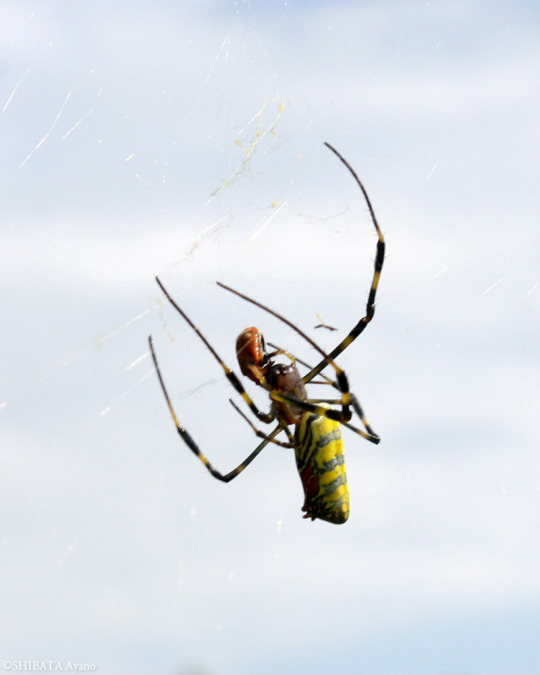
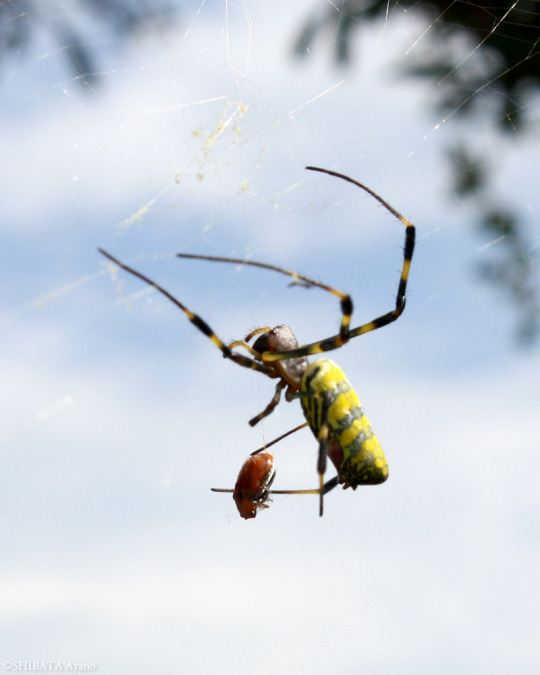
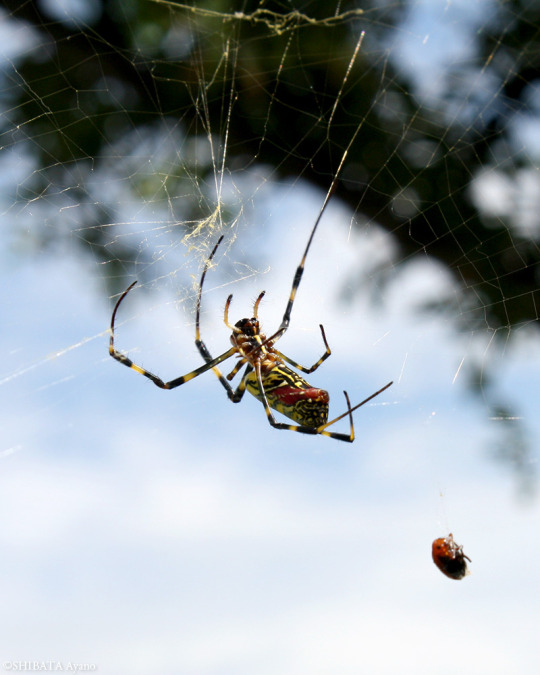
w moim odawarskim ogródku: Pająk Nephila clavata złapał chrząszcza Aulacophora femoralis.
in my garden in Odawara: The jorō spider (Nephila clavata) caught a cucurbit leaf beetle (Aulacophora femoralis).
【庭】ジョロウグモがウリハムシをつかまえた。
#spider#jorō spider#Nephila clavata#japan#pająk#cucurbit leaf beetle#Aulacophora femoralis#庭#garden#ogródek#蜘蛛#クモ#ジョロウグモ#ウリハムシ#昆虫#虫
1 note
·
View note
Text
Soil-Borne Pathogens Can Cause Plant Blight and Disease
By John Hibma – The crops we grow, especially vegetables, are subject to a number of different diseases and plant blight caused by soil-borne pathogens. Soil is full of organisms both good and bad. The good organisms include worms, slugs, snails, beetles, ants, and spiders as well as gophers and moles and even snakes. We may not think of snails or gophers as “good organisms” but through their activity in soil, they benefit its condition making it healthy and capable of sustaining plant life. Soil microorganisms whether big or small don’t live passive lives in the soil. They actively decompose organic matter, recycle nutrients, fix nitrogen, detoxify pollutants and maintain soil structure. Healthy soil is the foundation of successful agriculture.
Unfortunately, soil can harbor many bad organisms that can cause plant blight and other plant diseases. These pathogenic organisms include molds, fungi, bacteria, and nematodes. In most cases, all soils whether they be healthy or marginal will harbor pathogens that may potentially limit and even destroy a field or garden. Soil-borne pathogens usually cannot be completely eradicated from the soil so they must be managed in a way that will limit the harm they inflict on a crop.
Updated Composting Guide: Learn to compost chicken manure!
Avoid common composting mistakes with this Free Guide. Successfully make your own garden gold with help from our experts. YES! I want this Free Report »
How many of us growing tomatoes have seen scabs on them or pulled up a growing carrot from the ground only to find it hideously misshapen? Or bell peppers that wilt before our eyes or the beans that are covered with a powdery plant mildew. If anyone grows a garden or has ever attempted to grow a garden, sooner or later they will probably experience the disappointment and frustration of plants that turn yellow and lack vigor or fruit that rots on the vine. On a larger scale, commercial vegetable growers can see entire fields decimated by a pathogen and lose many hundreds or thousands of dollars of potential revenue.
General symptoms of soil-borne pathogens include leaf blight, wilting and stunting, seed decay, fruit rot and root rot. Several of the more common vegetable diseases and plant blights found in the Northeast U.S. are:
Phytophthora blight: this plant blight is caused by a water mold that will rot fruit and rapidly wilt and kill a plant.
Sclerotinia diseases: caused by a fungus that produces brown or gray lesions on foliage and fruit.
Common scab: caused by various Streptomyces species.
Verticilliuma: widespread mold that causes leaf wilt on many vegetable plants.
Nematodes: worm-like organisms that attack the root structure of plants.
Pathogen distribution in soils that results in plant blight and disease is highly dependent upon the cropping history of a particular soil, such as the types of crops grown and whether or not there has been any crop rotation over the course of seasons. Soil moisture and temperature can also influence the level of pathogen loading. Many diseases are more severe with high soil moisture. Soil pH and nutrient levels will also contribute to pathogen infection. Probably the single largest factor contributing to high levels of soil-borne pathogens is the health and integrity of the soil itself.
Healthy soil is a combination of minerals, air, water, and organic matter. Minerals in the form of sand, silt, and clay make up about 50% of good soil. Organic matter also known as humus makes up only a small portion of soils but is critical to the transfer of the chemical ions that are necessary for plant growth and fruit and vegetable production. Well-structured and stable soils are an ecosystem all to themselves with their own balance and interaction of organisms. It’s this healthy environment around the “root zone” of a plant that allows for biological suppression of plant pathogens and prevents parasitism and damage to plants. Blight and disease are easier to fend off with healthy soil, bottom line.
Generally, the first sign that soil-borne pathogens are infecting a crop is an obvious yellowing of plants. Don’t assume its plant blight or disease. Ruling out water, fertility or mineral deficiencies comes first, followed by inspection of leaves, stems, and roots.
As with many things in life, an ounce of prevention is worth a pound of cure. In the case of Phytophthora blight, the parasite is transferred through water. Cucurbits, Solanaceae, and legumes are all susceptible to this mold so testing the water source for the oospores that cause Phytophthora is highly recommended as well as not over-irrigating and controlling field drainage so as to not infect a neighboring field. Rotating plants from one part of a field to another as well as disposing of culled fruits somewhere where they won’t re-infect a field will help manage this disease.
According to researchers at the University of California, Sclerotinia diseases must be managed with a combination of cultural and chemical means. It’s best left to the grower/farmer as to whether chemical management for diseased plants is an option or not. Sclerotinic activity favors high moisture and high humidity and cooler temperatures. Rotation of crops is another important tool in managing the sclerotial population in soils. Sclerotinia does not affect grain or grass crops so rotating fields with corn or small grains between seasons may help control sclerotinia.
Verticillium wilt is a wilting condition on the stem and leaves caused by a fungus that affects nearly all vegetable varieties. This disease affects the vascular system of plants limiting its ability to transfer nutrients. It’s spread in the ground through root systems. Spores can remain viable for over a decade which makes eradication from a field nearly impossible. One of the few ideas for plant fungus treatment is anaerobic conditions such as flooding, which of course, is counter-productive in many other ways.
Nematodes are microscopic worm-like organisms that live most of their life-cycle in the root systems of plants. Root-knot nematodes infect vegetables throughout the United States, impacting both the quantity and quality of marketable yields. Above ground symptoms include stunting and uneven growth. Carrots will be greatly misshapen with multiple forking; onions and garlic will have bulbs that are poorly formed and misshapen. The bloat nematode will affect onions, garlic, and leeks with stunting, withering and yellowing of leaves along with the swelling of the stems and bulbs.
Research from Cornell University recommends rotating onions, carrots, or lettuce with a non-host crop such as sweet corn and other grain crops to control nematodes. Sudangrass is a non-host to the root-knot nematode and when incorporated as a green manure will further suppress the soil population of this nematode. The use of cover crops grown between the main crops may provide an alternative management strategy. The use of pre-planting fumigants have been found to be very effective in controlling nematodes but are very expensive and their use is highly regulated.
Growers need to be aware that, when dealing with a soil-borne pathogen, the same management strategies don’t always work in all field situations to ward off plant blight and disease. Each pathogen and cropping system must be considered individually when developing a strategy to manage a pathogen. Once pathogens are detected, though, cultural practices such as crop rotation and bio-security measures are the most effective ways to manage the parasites. Introduction of resistant cultivars of a plant variety (when available) will also limit pathogen damage.
Once soil-borne pathogens have established themselves in soils it’s very difficult to eradicate them. Soils that are marginal in quality and healthmeaning that plants have a difficult time getting established and growing will be more inclined to contain soil-borne pathogens. Soils with higher levels of organic matter (humus) will support more of the good organisms and exclude the pathogenic organisms. Soil management practices may also have a negative effect on soil health which opens the door for pathogenic organisms to get a foothold. Increased tillage (plowing and disking) tends to decrease the soil’s biomass. The application of manure and compost will improve the humus levels in soil. A healthy soil has good tilth and drainage, is resistant to degradation and is resilient under adverse conditions. That soil will support a large population of non-pathogenic organisms and exclude those organisms that are pathogenic.
Originally published in Countryside 2012 and regularly vetted for accuracy.
Soil-Borne Pathogens Can Cause Plant Blight and Disease was originally posted by All About Chickens
0 notes
Text
Soil-Borne Pathogens Can Cause Plant Blight and Disease
By John Hibma – The crops we grow, especially vegetables, are subject to a number of different diseases and plant blight caused by soil-borne pathogens. Soil is full of organisms both good and bad. The good organisms include worms, slugs, snails, beetles, ants, and spiders as well as gophers and moles and even snakes. We may not think of snails or gophers as “good organisms” but through their activity in soil, they benefit its condition making it healthy and capable of sustaining plant life. Soil microorganisms whether big or small don’t live passive lives in the soil. They actively decompose organic matter, recycle nutrients, fix nitrogen, detoxify pollutants and maintain soil structure. Healthy soil is the foundation of successful agriculture.
Unfortunately, soil can harbor many bad organisms that can cause plant blight and other plant diseases. These pathogenic organisms include molds, fungi, bacteria, and nematodes. In most cases, all soils whether they be healthy or marginal will harbor pathogens that may potentially limit and even destroy a field or garden. Soil-borne pathogens usually cannot be completely eradicated from the soil so they must be managed in a way that will limit the harm they inflict on a crop.
Updated Composting Guide: Learn to compost chicken manure!
Avoid common composting mistakes with this Free Guide. Successfully make your own garden gold with help from our experts. YES! I want this Free Report »
How many of us growing tomatoes have seen scabs on them or pulled up a growing carrot from the ground only to find it hideously misshapen? Or bell peppers that wilt before our eyes or the beans that are covered with a powdery plant mildew. If anyone grows a garden or has ever attempted to grow a garden, sooner or later they will probably experience the disappointment and frustration of plants that turn yellow and lack vigor or fruit that rots on the vine. On a larger scale, commercial vegetable growers can see entire fields decimated by a pathogen and lose many hundreds or thousands of dollars of potential revenue.
General symptoms of soil-borne pathogens include leaf blight, wilting and stunting, seed decay, fruit rot and root rot. Several of the more common vegetable diseases and plant blights found in the Northeast U.S. are:
Phytophthora blight: this plant blight is caused by a water mold that will rot fruit and rapidly wilt and kill a plant.
Sclerotinia diseases: caused by a fungus that produces brown or gray lesions on foliage and fruit.
Common scab: caused by various Streptomyces species.
Verticilliuma: widespread mold that causes leaf wilt on many vegetable plants.
Nematodes: worm-like organisms that attack the root structure of plants.
Pathogen distribution in soils that results in plant blight and disease is highly dependent upon the cropping history of a particular soil, such as the types of crops grown and whether or not there has been any crop rotation over the course of seasons. Soil moisture and temperature can also influence the level of pathogen loading. Many diseases are more severe with high soil moisture. Soil pH and nutrient levels will also contribute to pathogen infection. Probably the single largest factor contributing to high levels of soil-borne pathogens is the health and integrity of the soil itself.
Healthy soil is a combination of minerals, air, water, and organic matter. Minerals in the form of sand, silt, and clay make up about 50% of good soil. Organic matter also known as humus makes up only a small portion of soils but is critical to the transfer of the chemical ions that are necessary for plant growth and fruit and vegetable production. Well-structured and stable soils are an ecosystem all to themselves with their own balance and interaction of organisms. It’s this healthy environment around the “root zone” of a plant that allows for biological suppression of plant pathogens and prevents parasitism and damage to plants. Blight and disease are easier to fend off with healthy soil, bottom line.
Generally, the first sign that soil-borne pathogens are infecting a crop is an obvious yellowing of plants. Don’t assume its plant blight or disease. Ruling out water, fertility or mineral deficiencies comes first, followed by inspection of leaves, stems, and roots.
As with many things in life, an ounce of prevention is worth a pound of cure. In the case of Phytophthora blight, the parasite is transferred through water. Cucurbits, Solanaceae, and legumes are all susceptible to this mold so testing the water source for the oospores that cause Phytophthora is highly recommended as well as not over-irrigating and controlling field drainage so as to not infect a neighboring field. Rotating plants from one part of a field to another as well as disposing of culled fruits somewhere where they won’t re-infect a field will help manage this disease.
According to researchers at the University of California, Sclerotinia diseases must be managed with a combination of cultural and chemical means. It’s best left to the grower/farmer as to whether chemical management for diseased plants is an option or not. Sclerotinic activity favors high moisture and high humidity and cooler temperatures. Rotation of crops is another important tool in managing the sclerotial population in soils. Sclerotinia does not affect grain or grass crops so rotating fields with corn or small grains between seasons may help control sclerotinia.
Verticillium wilt is a wilting condition on the stem and leaves caused by a fungus that affects nearly all vegetable varieties. This disease affects the vascular system of plants limiting its ability to transfer nutrients. It’s spread in the ground through root systems. Spores can remain viable for over a decade which makes eradication from a field nearly impossible. One of the few ideas for plant fungus treatment is anaerobic conditions such as flooding, which of course, is counter-productive in many other ways.
Nematodes are microscopic worm-like organisms that live most of their life-cycle in the root systems of plants. Root-knot nematodes infect vegetables throughout the United States, impacting both the quantity and quality of marketable yields. Above ground symptoms include stunting and uneven growth. Carrots will be greatly misshapen with multiple forking; onions and garlic will have bulbs that are poorly formed and misshapen. The bloat nematode will affect onions, garlic, and leeks with stunting, withering and yellowing of leaves along with the swelling of the stems and bulbs.
Research from Cornell University recommends rotating onions, carrots, or lettuce with a non-host crop such as sweet corn and other grain crops to control nematodes. Sudangrass is a non-host to the root-knot nematode and when incorporated as a green manure will further suppress the soil population of this nematode. The use of cover crops grown between the main crops may provide an alternative management strategy. The use of pre-planting fumigants have been found to be very effective in controlling nematodes but are very expensive and their use is highly regulated.
Growers need to be aware that, when dealing with a soil-borne pathogen, the same management strategies don’t always work in all field situations to ward off plant blight and disease. Each pathogen and cropping system must be considered individually when developing a strategy to manage a pathogen. Once pathogens are detected, though, cultural practices such as crop rotation and bio-security measures are the most effective ways to manage the parasites. Introduction of resistant cultivars of a plant variety (when available) will also limit pathogen damage.
Once soil-borne pathogens have established themselves in soils it’s very difficult to eradicate them. Soils that are marginal in quality and healthmeaning that plants have a difficult time getting established and growing will be more inclined to contain soil-borne pathogens. Soils with higher levels of organic matter (humus) will support more of the good organisms and exclude the pathogenic organisms. Soil management practices may also have a negative effect on soil health which opens the door for pathogenic organisms to get a foothold. Increased tillage (plowing and disking) tends to decrease the soil’s biomass. The application of manure and compost will improve the humus levels in soil. A healthy soil has good tilth and drainage, is resistant to degradation and is resilient under adverse conditions. That soil will support a large population of non-pathogenic organisms and exclude those organisms that are pathogenic.
Originally published in Countryside 2012 and regularly vetted for accuracy.
Soil-Borne Pathogens Can Cause Plant Blight and Disease was originally posted by All About Chickens
0 notes